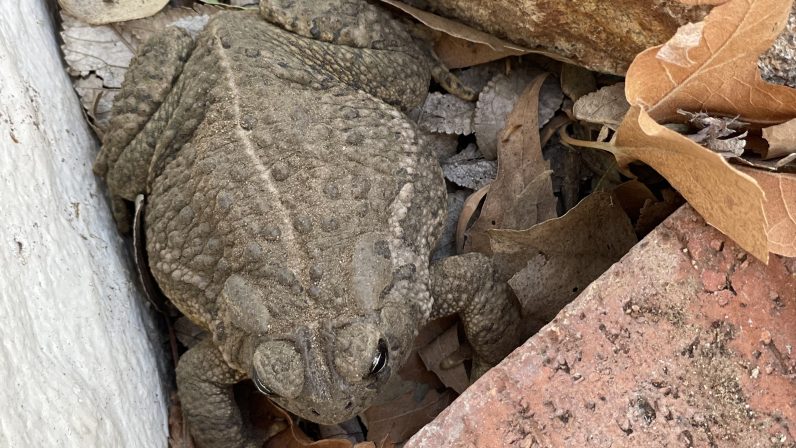I can’t help myself from writing about the great outdoors. It’s full of surprises, discoveries, and inspiration. On Wednesday morning we were surprised by a visit from a neighborhood toad. It was about the size of a medium baked potato, and didn’t seem to be in a hurry to go anywhere else. One of the kids discovered it, and before long there was a crowd surrounding the toad. It was nestled carefully between the wall of a low enclosure and some rocks and bricks. Waiting and figuring out what to do next.
As we called children over to see it, there were lots of questions and concerns. More than one child asked, “Is it poisonous?” I ensured them the toad was a harmless common toad and wouldn’t hurt anyone. The gathering of observers eventually dispersed, the bell rang for classes to begin, and I turned to my tasks of the day. I didn’t see the toad again, but I’ve thought of it quite often since we noticed it.
Mostly that toad reminded me of my childhood in rural Nebraska. Toads were a regular part of our lives as kids, given that they regularly appeared in the open fields surrounding our home. We captured them on a regular basis, finding creative ways to integrate toads into our play. They were among the many creatures we caught and released, including snakes, salamanders, field mice, and baby birds. Creatures were a normal part of our days and taught us much about the life cycle. They were symbolic of the freedom woven into our young lives that was deeply rooted in the natural world.
I’m often concerned about the absence or limitation of this relationship with the natural world for today’s children. Some of it is a product of where and how we live, especially in urban settings. Many children never have the experience of roaming freely without an adult hovering nearby. I’m all for safety, and appreciate the various levels of safety and support for emotional well being available to children these days. Still, when it comes to interacting with nature, it feels like they’re missing out on a valuable childhood experience that was so key to my own development.
It goes without saying that whenever possible, it’s our intention to recreate experiences similar to my childhood here at the Seed. The gardens, outdoor classroom areas, trees, Gwen’s Castle, and small wild spaces become natural habitats where creatures, like the toad, can settle in. This gives our students opportunities for experiences they might not otherwise have. Even though they won’t receive the full immersion I had as a child, perhaps it will give them enough exposure to inspire curiosity and wonder…and deepen their connection to Planet Earth.


Hi Mary – I love this. I went to the Botanical Gardens recently and we saw a toad there in the pond. We pondered on him for a little bit. I was on uneven ground while we were observing him and I suddenly thought – if he jumps I will lose my balance and fall on my tush, so we stepped back. The gardens were stunning. Love you!